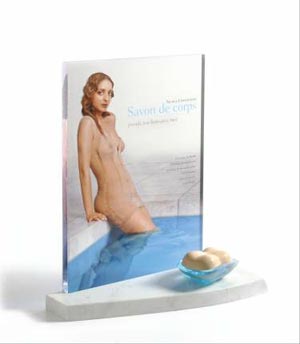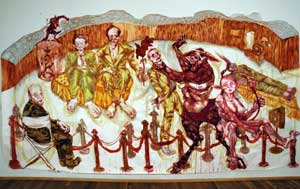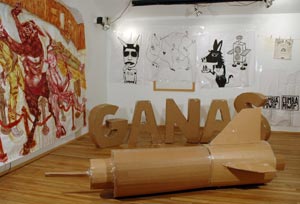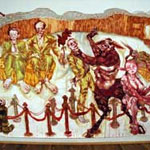The Donkey Show
The Donkey Show, in its use of a domestic setting for a gallery and its inclusion of an out-of-town artist, continues two new Austin trends. For this inaugural show, Austin's Ali Fitzgerald and San Antonio's Cruz Ortiz provide a slap-it-down, throw-it-up presentation of their work. Both use ink, paper, comic-inspired sensibilities and a laissez-faire kind of attitude.
Coming 'round the back entrance, I am greeted by Ortiz's sound piece. Aii, mamacita, what did I just walk into? I find stark black ink drawings on white sheets of letter-sized paper hung on tweed rope by clothespins. Some larger sheets are scotch-taped to the wall — to make sure they stay flat, I guess, as there are multiple fold creases visible. On the floor in the centermost part of the L-shaped gallery are two cardboard and scotch-tape sculptures. One is of a rocket and the other is the Spanish word ganas (roughly translated, "desire") in all caps. The imagery ranges from the text "Cumbia Power" to a treasure map akin to a board game to portraits of figures I dub Burro Boy and his chica. With their high contrast and simple mark making, the drawings look like excerpts from a newspaper comic strip. This graphic style suits the more fantastical aspects, such as the map, but fails to convince me of the relationship between Burro Boy and the Donkey Show (Burro Boy appears to be autobiographical and just wants to get his "Cumbia" on). The sculptures suggest yet another tangent. They relate in their low-tech construction, but the imagery is not as immediate.
In the other half of the gallery, Fitzgerald has suspended carnivalesque imagery. Here we are presented with a more emphatic comic book style compared to her usual comic book/graffiti image making. On the side walls hang cutouts forming a group portrait of what appears to be a donkey hybrid family. Some characters are wild-eyed and intense, while others clearly have donkey features like large ears or protruding muzzles. Drips are noticeably absent from these works. On the main wall of the gallery, Fitzgerald provides a panoramic view of a donkey show in action. Inside a smurfy-looking cavern, a donkey woman is giving lap dances to some nasty freaks. Sight lines attack you from every which way as Fitzgerald explores this grotesquely hypnotizing voyeuristic power trip. This group of works reads as more didactic than previous pieces and lacks the exciting sifting of ideas that was brought on by the drips in those earlier works. The lack of drips suggests the use of a more cautious process.
Each artist has played with the idea of a donkey show following different avenues of thought. Fitzgerald is more interested in the power of a gaze, while Ortiz enjoys the thrill of the hunt. Placed next to each other, they suggest the lure of a forbidden furry fruit .
Testsite
The show at Testsite was up for a good three weeks before I had a chance to visit. In that time, I read the interview with the collaborators. The concept of collaborating with the same institution that has invited you to collaborate with someone else sounded like a cop-out — like a very academic exercise in conceptualism. But I was curious to see how I would experience it.
When I finally make my way into the gallery and the space, Exercise #2 is displayed in the foyer and to the right. (Hey, isn't Testsite Austin's original gallery in a home? If not, I think it's the oldest still in operation.) In the living room area of the house is the main gallery and Exercise #1. Books, opened to the acknowledgment page, are displayed throughout the room on shelves at about waist height. In the back corner sits a small group of posters/paintings, wrapped and placed against each other so that only their backs are visible through the enveloping plastic. On the center coffee table, stacks of books are treated the same way. Even though this is the living room in a house, it feels like a white box.
Risa Puleo, owner of the Donkey Show and docent at Testsite, comes down to welcome me as she begins her duties. I listen politely as she goes through her spiel, for the umpteenth time I imagine. What can she possibly be selling if nothing is for sale in this experimental space? Almost verbatim from the website and the interview, she describes the collaboration between Ursula Davila Villa and Carla Herrera-Pratt, and how they decided to turn the mirror on Testsite and Fluent Collaborative through the use of Lawrence Weiner. In a serendipitous series of events, Lawrence Weiner became the catalyst for discussing and exposing the relationships of collaborators in general and the collaborators of this project.
As I sit chatting with Puleo without knowing who Lawrence Weiner is, she finally tells me who he was and what he practiced. Snap! My association of the open books with R2D2 projecting the hologram of Princess Leia gains further justification. By pointing them out, the acknowledgments of both Lawrence Weiner and the two artists become visible and thus more real.
The portraits that I create in the space are fuzzy like the Leia hologram, but understanding the Lawrence Weiner connection brings in better reception. I enjoy the mental exercise, but wonder who outside the academic audience will find it as amusing.
Volitant
Volitant joins Fielding Lecht and the three art spaces on Congress Avenue — AMOA, Arthouse and Mexic-Arte — in downtown Austin. With its fancy digs, this is another high-quality, contemporary, commercial art gallery in Austin alongside Lora Reynolds. With its library collection and oddly shaped, yet quaint space, Volitant at least seems casual enough to fit Austin, but it is aggressively haughty. Viewing its super-duper high ceilings, marble floors and a minimum price tag starting at $5,000, I question their marketing plan. But enough about the chilly-willies I get from commercial galleries. They have art in there!
Walking up the sidewalk, I find that the gallery windows are filled with stylish clothing and accessories. They look a little odd, as if someone tried making leather using pigskins but retained the original pigment. Once inside the gallery, I am greeted by man-junk. It takes me a second as I look at the photograph of a bandaged soccer player lying in the sun. I first assume the bandages are completely covering the athlete's body, but no, his penis is lying there just as plain and relaxed as its owner. Marcos Lopez has hand-colored these giant photographs, which present awkward and somewhat humorous portraits of masculinity. Mexican Cowboy presents a blue-eyed, blond, almost albino individual dressed in colorful cowboy attire. The bluest jean jacket, the brightest green and red shirt, and the cleanest cowboy hat poke fun at the origins of cowboys, their current position in the public mind thanks to Brokeback Mountain, and the use of this attire among young Mexican men when they go out in search of a lady.

Nícola Costantino...Savon de Corps, 2004...Acrylic, plexi, carrara marble, dura clear (photo),...97% soap, 3% essence of Nicola ...Dimensions variable
Passing Lopez's work, I check out the wardrobe at the windows. Nicola Constantino has created this apparel with real human hair and silicon used to emulate human skin and blemishes. Nipples and moles are elements that Constantino uses in making patterns. It's a little freaky. I head into the gallery and turn into one of the smaller spaces where Constantino has set up a little booth to sell her product 'savon de Corps." Essentially she is selling her own extracted fat in the form of soap. Posters, a video commercial and other advertisement techniques sell you on the idea that this beauty product can help you disguise or remove your imperfections. I laugh because it looks so identical to real product salesmanship. In the next room, Cuban artist Esterio Segura displays large white-on-black drawings. In a blueprint style, they depict old automobiles with additions and modifications that make them appear transformed into submarines.
Stepping out of that room, I find Courtney Smith's sculpture and photographs. The photos show a large wardrobe that folds into itself and creates a dresser with mirror. On the floor, the sculpture looks like a deconstructed chair or some other large piece of furniture. I want it to transform like the piece in the photos, but it just sits there. In close proximity is a large crate with a ceramic vase on top by Eduardo Sarabia. Behind it are shelves filled with hand-blown bottles of authentic Mexican tequila. On the wall next to this installation and around the corner are some watercolor drawings by Alexandre Arrechea. These works are forgettable in such a strong group show. Patrick Hamilton has some utensils hanging next to Arrechea's work. The catalogue says the images on the blades are painted on, but when I look at them, they appear to be decal applications. The buckets on the floor are more interesting anyway: simple galvanized buckets transformed into light boxes as photographs of the Santiago, Chile, night skyline cover their brims. The most attractive part is the black wires reaching out from the bottom of the buckets and clinging to the floor's power outlets.
Above the buckets are some collages by Maximo Gonzalez. They are playful yet sad pieces, outdated bank notes that Gonzalez has cut up into decorative elements. The color and design merrily dance across the sheet, but the history of the object makes it a downer. In the centermost part of the gallery, Liset Castillo has some interesting photographs. At first glance, these large photographs appear to record the existence of some highway overpass or roadway system. In fact they are models copying existing transportation structures, photographed to present themselves as the originals. The swirling of the roads recall Katalin Hausel's piece for CinemaTexas back in November. Lastly, there is the work by Fernanda Brunet. The floral landscapes look strikingly similar to the patterns of superflat artist Takashi Murakami. The psychedelic colors camouflage the flowers at first, but looking at the shapes quickly reveals the content.
Art Palace
After I found out about this special event for Eduardo Navarro, I was invited to come meet the artist at his reception at Art Palace. I show up to find a POD storage unit in the driveway. I go around it to say hi to owner Arturo Palacios, and I am introduced to the art world writers. I am almost introduced to the artist, but I shy away and go to look at the art before I face him.
Walking into the brightly lit POD, I find it covered in drawings. Most are simple graphite on letter-sized sheets tacked to the wall. The largest, hanging on the back wall, is a 24 x 36-inch graphite on newsprint rendition of a space shuttle with balloons flying out of the open hatch. Nothing complicated about the imagery. All of them are line drawings rendered using a nervous, jerky line. From far away they looked clean, like confident contour drawings, but close up they are jaggedy and comparable to a simple digital drawing made in MS Paint.
I keep thinking of the work as simple. The mark making is not complex. The images are only a few elements on the page. The materials used are readily available. Maybe that's why I'm not fond of them. I was expecting something brainier. But while the construction of these drawings feels limited, the content is whispering something. I can't hear anything, but I can see it move its lips. There's something sinister running through the works that I'm not picking up on.
Toward the back of the POD and at or below waist level is a sculpture. It consists of a yellow balloon attached to a small, clear hose that is attached to a plastic blowup of a penis. After seeing this piece, I take note of the drawings with an erotic or what I thought were homosexual references. Is that it? Is he gay? Is that what I was missing? I didn't see it in all of the works, so I put that thought aside. I'm about to head out when Palacios introduces me to Navarro. It throws me way off and my mind blanks. I ask if we can chat later.
Saturday afternoon I return to Art Palace to check out both the gallery's current show and Navarro's work. The artist is sitting in front of the gallery eating a bag of chips. I say hi, look around the show inside and come back out to chat. I find out that drawing is a daily practice for him, and this show worked well logistically since his sculptures are larger. On the porch is a costume, which I didn't see the first night, as evidence of one of his performances. He concedes that it is out of context. I hadn't resolved the drawings for myself, so I ask Navarro about them. He describes wanting to create or present something that is innocent or fresh. Something naive because nothing can ever truly be innocent. So the drawings look like what I would call childish, but hold some adult content. So, I guess I was right?
Images courtesy the artists and galleries.
Jaime Castillo is a writer living in Austin.






